“A girl is crossing the street. Is she the younger or the older sister?”
Rather obviously, the question is impossible to answer using judgement. And yet this is precisely the question a student of Zen may be asked as koan - a question to test a student’s understanding of Zen.
In The Way of Zen, Alan Watts writes
“Such koan are rather more obviously “tricky”… and show the student that what are dilemmas for thought present no barriers to action… the student solves the problem of the younger or older sister by mincing across the room like a girl. For in her absolute “suchness” the girl is just that; she is only relatively “sister,” “older,” or “younger.”
One can perhaps understand why a man who had practiced za-zen for eight years told R. H. Blyth that “Zen is just a trick of words,” for… Zen is extricating people from the tangle in which they find themselves from confusing words and ideas with reality.”
Indeed. Let’s do a perhaps silly thing, and use words to define “suchness” as the true, concrete essence of things as they really are, without words or other ideas attached to them.
The “solution” of the koan as described above made me think of sign language - the language used by deaf people to communicate with each using their hands and body language.
“But wait Krystof! In that video you’re just translating words - that’s not suchness!”
‘Tis true, and that’s where classifiers come in.
Classifiers are, put in my imperfect layman’s terms, hand shapes and movements that are not based on signs assigned to specific words, but rather on the shapes and movements of the hands in an iconic fashion - i.e. as icons. For example, a horse jumping over a fence may be represented by having the stationary hand be the fence and the moving hand be the horse. See Wikipedia for some more information.
But videos are worth so much more than words, so here’s a great example from the one and only Troy Kotsur:
There are no subtitles during the classifier, and yet I bet you know exactly what Troy is talking about.



